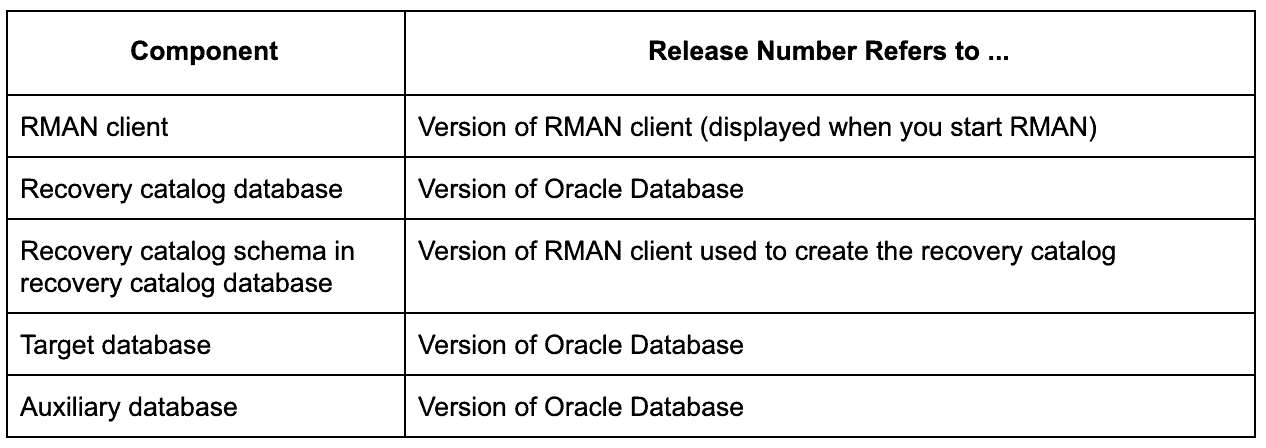How To Register A Catalogo For Rman
Recovery Catalog Purpose:
The RMAN recovery catalog is a schema created inside of a new or existing database that is used to shop metadata almost Oracle databases. Information technology's recommended by XTIVIA that the itemize exist created in its ain dedicated database due to the importance of its role in database recovery. A few benefits for the recovery catalog include:
- The recovery catalog stores database metadata history for much longer than the controlfile. Also, if the target database's controlfile and all backups are lost, the metadata is still stored inside of the recovery catalog.
- The recovery catalog can be used as a centralized location to store information nigh all of your Oracle databases. This makes it much easier to run various reports nigh the backups.
- If the preferred method is using backup scripts instead of command files, they can be stored in the database for safekeeping. This is useful when the server is lost and the fill-in scripts along with information technology.
Recovery Catalog Concepts:
Enrolling a database in a recovery catalog for use with RMAN is called "registration." It'south recommended that all databases in the environment are registered in a single recovery catalog. This helps keep that centralized metadata repository mindset for Oracle backups.
For access to the recovery catalog, permissions will demand to be granted by the owner of the centralization recovery itemize. This is as well known as the "base Recovery catalog." Information technology tin can revoke permissions already given or grant new permissions to others. Each user of the recovery catalog has full access (read/write) to their own metadata. This is called a "virtual private itemize." The recovery itemize owner picks which objects each virtual private itemize user can admission.
When running backup, restore, and cantankerous-checking commands, RMAN first updates the controlfile and so the metadata within of the recovery catalog. This process of syncing data is known every bit "recovery catalog resynchronization." This ensures that RMAN has the correct metadata from the controlfile.
As mentioned higher up you're able to store scripts inside of the recovery catalog. There are two types of scripts, local and global. The local scripts are assigned to a target database registered with the catalog. The local scripts can only be used by the target database. The global scripts tin can be used for any registered database in the recovery catalog. In society to edit the global scripts, we must starting time connect to the "base recovery catalog."
In order to manage backups between a main and standby database in a Information Guard configuration, information technology'southward highly recommended to have a recovery itemize. There are ways to take standby backups and restore them; however, the recovery catalog makes that process much easier and is a all-time practice recommended by Oracle as well.
Create an RMAN itemize:
Refer to the charts below for RMAN compatibility.


To create an RMAN catalog, you commencement need to create a user with the correct privileges. Connect to a new or existing database where the catalog will reside. You will then create a user and grant the user the RECOVERY_CATALOG_OWNER role. Starting with Oracle 12.1.0.2 the recovery itemize database must use Enterprise Edition. Your recovery catalog database needs to be the same version or higher than the database you are creating the catalog for.
SQL>create user reco_cat identified by password
default tablespace tablespace_name
quota unlimited on tablespace_name;
SQL>grant create session to reco_cat;
SQL>grant recovery_catalog_owner to reco_cat;
Once the user has been created, you can now connect to the recovery itemize database and create the itemize. Make sure you have updated the tnsnames.ora file with an entry to the recovery catalog database. From the command prompt log into RMAN and connect to the recovery itemize database, reco_db.
cmd> rman
RMAN>connect catalog reco_cat/countersign/@reco_db
RMAN>create catalog;
Once the catalog has been created you tin at present register the database.
RMAN>connect target /
RMAN>register database;
Congratulations, you're at present ready to perform RMAN operations in conjunction with an RMAN recovery catalog for your newly registered database.
How To Register A Catalogo For Rman,
Source: https://www.virtual-dba.com/blog/how-to-create-an-rman-recovery-catalog-in-oracle-18c/
Posted by: stewartupoessiond.blogspot.com


0 Response to "How To Register A Catalogo For Rman"
Post a Comment